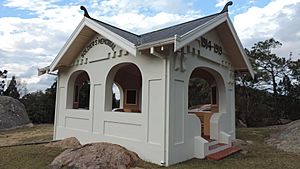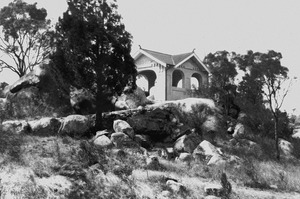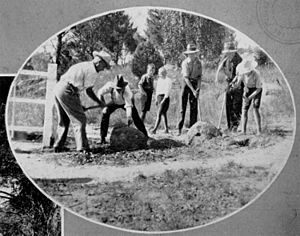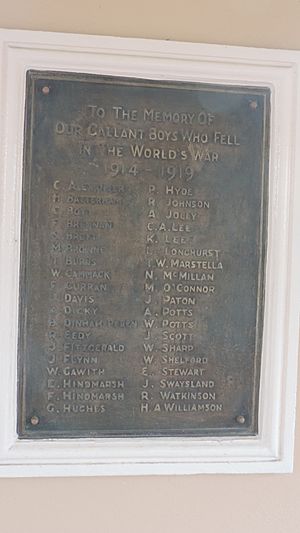Stanthorpe Soldiers Memorial facts for kids
Quick facts for kids Stanthorpe Soldiers Memorial |
|
|---|---|

Stanthorpe Soldiers Memorial, 2015
|
|
| Location | Lock Street, Stanthorpe, Southern Downs Region, Queensland, Australia |
| Design period | 1919–1930s (interwar period) |
| Built | 1925–1926 |
| Architect | Dornbusch & Connolly |
| Official name: Stanthorpe Soldiers Memorial, Stanthorpe War Memorial | |
| Type | state heritage (landscape, built) |
| Designated | 3 August 1995 |
| Reference no. | 601632 |
| Significant period | 1920s (fabric) |
| Significant components | flagpole/flagstaff, memorial – pavilion, steps/stairway, memorial – tree/avenue of trees, plaque, wall/s – retaining, pathway/walkway, terracing, memorial – honour board/ roll of honour, trees/plantings, furniture/fittings, seating |
| Builders | N J Thompson & Sons |
| Lua error in Module:Location_map at line 420: attempt to index field 'wikibase' (a nil value). | |
The Stanthorpe Soldiers Memorial is a special place in Stanthorpe, Australia. It's a war memorial that honors soldiers. This important site is located on Lock Street. It was designed by architects Dornbusch & Connolly. Local builders N J Thompson & Sons built it between 1925 and 1926. The memorial is also known as the Stanthorpe War Memorial. It was officially opened on February 6, 1926, by Sir William Glasgow. Today, it is listed on the Queensland Heritage Register. This means it's a protected historical site.
History of the Memorial
The Stanthorpe Soldiers' Memorial was built to honor soldiers from the area. These soldiers fought in World War I, also called the Great War. People in the community raised money to build this memorial. Many memorials across Queensland were built this way. Stanthorpe's memorial is a park with a small building called a rest house. It sits on Foxton's Hill, which overlooks Stanthorpe.
The rest house was designed by architects Dornbusch and Connolly. Local builders N J Thompson and Sons constructed it. Inside the rest house, there were seats. On the walls, there were five special lists called "rolls of honor." One of these lists was for soldiers who had died. Major General Sir William Glasgow officially opened the memorial. He was a commander in battles like Gallipoli and in France.
Planning the Memorial Site
The idea for a memorial in Stanthorpe started on December 1, 1918. A group was formed to collect money. At first, they thought about building it on Mt Marlay. This is a main lookout point for the town. But they decided against it. By 1921, they looked for other ideas.
Some people suggested building it on new cricket grounds. Others liked a piece of land on Foxton's Hill. This land was high up and close to town. A person named CF White suggested building a rest house there. He also thought they could make the land a memorial park with seats. On May 21, 1921, the committee agreed to buy the Foxton Hill site. They asked Dornbusch and Connolly to draw up plans for the rest house.
Building the Rest House
The chosen site was rough and rocky. The main park area faced Lock Street. Two smaller parts faced White Street. In 1923, the committee officially bought the memorial site. They asked Dornbusch and Connolly to prepare building plans. They wanted to use local stone or concrete.
Work on the rest house did not start until 1925. This was because they needed more money. Even before the rest house was built, the site was special. A Turkish gun was placed at the Lock Street entrance. This gun was a war trophy. It was brought to Australia by Sir Harry Chauvel, a commander.
Changes Over Time
We don't know if trees were planted before the rest house was finished. But by the 1930s, photos show pine trees around the rest house. These pines are thought to be "Lone Pines." More pines were planted on the western side of the site. Wooden markers with soldiers' names were placed under these trees.
By 1933, a blue light shone from the memorial at night. You could see it from the town center. Two memorial eucalyptus trees were planted at the Scholz Street entrance. In the 1980s, the floor of the rest house was painted. The ceiling was painted blue with stars. The Turkish Gun was moved. It is now in front of the RSL building.
Anzac Day Services
For many years, Anzac Day was celebrated at the Soldiers Memorial. It started with a Dawn Service at the memorial. Then there were morning services at churches. In the afternoon, a public service was held. Soldiers would march through the streets. The CWA provided afternoon tea for soldiers' families. More recently, the Dawn Service has been held at Weeroona Park.
Until 1963, the memorial was cared for by public donations. Local people, often returned soldiers, also helped maintain it. They took care of the landscaping and planting. These people included Mr AH Hocking and Mr and Mrs AE Bateman. More recently, a group called the Friends of the War Memorial helps.
The Stanthorpe Soldiers Memorial building is about 6.15-by-4.6-metre (20.2 ft × 15.1 ft). It held five Honour Rolls. After World War II, a sixth was added. More honor boards have been placed there for other conflicts. The land around the building has also been landscaped.
What the Memorial Looks Like
The Stanthorpe Soldiers' Memorial is on Foxtons Hill. It's a short walk from the town center. It's a rugged parkland that covers about one and a half hectares. There are walking paths that lead to the rest house at the top of the hill. Lock Street is to the north of the site. Other houses are on the other sides.
The main entrance is from Lock Street. You can also get in from White Street and Scholz Street. The Scholz Street entrance has two large eucalyptus trees. They frame the view of the rest house up a long slope.
Park Features
The site is rough and rocky. It has exposed granite boulders and different kinds of plants. The landscaping looks natural. There are bush pathways and some concrete stairs. Some paths have seats cut out of the rock. There are also stone walls and terraced areas. You can see some formal planting along the paths, like yellow jasmine hedges.
The site also has many memorial trees. Some are believed to be Lone Pines. They surround the rest house. There are also stands of pines on the western edge of the site.
The Rest House
From Lock Street, you walk up several concrete stairs to reach the rest house. The rest house sits among exposed granite boulders at the top of the hill. There is a flagpole to the south. Retaining walls and stairs are to the south and west.
The rest house faces east and west. It has arched openings that offer views. To the west, you can see a wide view of Stanthorpe and the area. The rest house is a white concrete building. It has a painted corrugated roof with four gables. On the east and west gables, it says "SOLDIERS' MEMORIAL" in raised concrete letters. On the north and south gables, it says "1914–19."
You enter the rest house through arched openings on the north and south sides. Inside, the ceiling is made of pressed metal. It's painted light blue with gold plastic stars. The floor is painted red. Along the east and west walls are two long wooden seats.
On the walls are five World War I honor boards made of metal. They are set into concrete frames. One board is for the names of those who died. It says: "TO THE MEMORY OF OUR GALLANT BOYS WHO FELL IN THE WORLD'S WAR 1914–1919." The names are listed in alphabetical order. There is also an honor board for World War II and a plaque for the Korea.
Why This Place is Special
The Stanthorpe Soldiers Memorial was added to the Queensland Heritage Register on August 3, 1995. It's important for several reasons:
A Unique Memorial
This memorial is very special. It has a rest house inside a rugged park. It's different from other memorials in Queensland. Many memorials are in town centers. But this one is on the edge of town. It's a place for public memory and also for quiet reflection.
Showing Queensland's History
The memorial helps us understand Queensland's history. It shows how communities honored their soldiers after the Great War. It's a strong reminder of the past.
A Place for Reflection
With its memorial trees and natural landscaping, the memorial is a place for remembering. The rock seats and bush paths lead up to the rest house. The rest house is placed so you can see the sunrise and sunset through its arches. It's a place for both remembering and thinking quietly.
Beautiful and Meaningful
The site has rough terrain and exposed granite rocks. This makes it look wild and natural. This landscape is unique to the area. It also reminds people of places like Gallipoli and the Turkish coast, where battles were fought.
Important to the Community
The Stanthorpe Soldiers Memorial honors those who served in the Great War and other wars. It also shows how dedicated the community was. They built the memorial and continue to care for it today.




